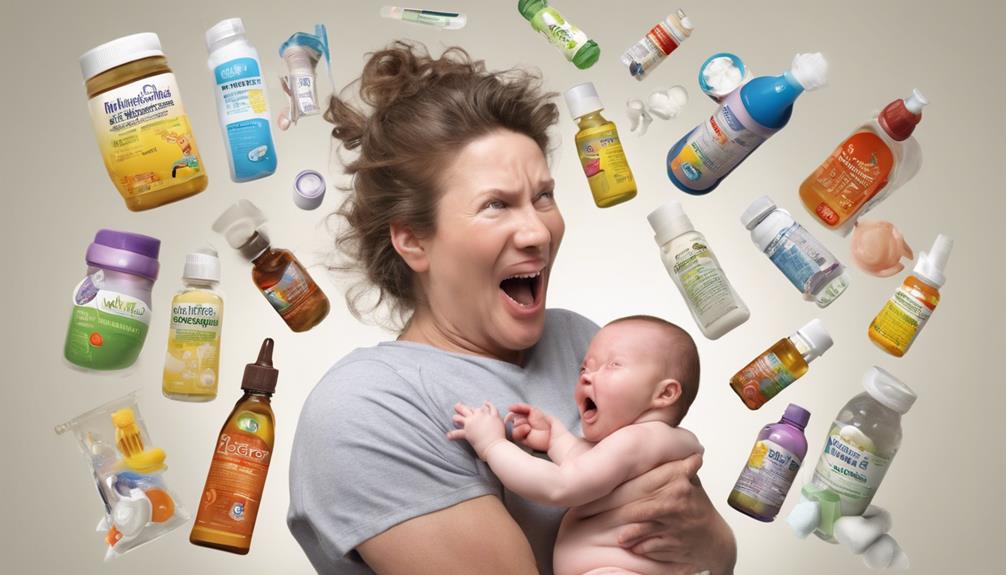In our journey through the complex network of newborn care, the ‘Essential Newborn Care Nursing Guide’ acts as our beacon, directing us through the subtle intricacies of Early Essential Newborn Care.
With its detailed recommendations and practical insights, this guide is a beacon of knowledge for healthcare professionals seeking to enhance their skills in newborn care.
The depth of information it offers can truly transform the way we approach these important first moments of a newborn's life, setting a foundation for best care and outcomes.
Key Takeaways
- Regular monitoring of vital signs and responses is crucial for newborn health.
- Proper feeding and nutrition, including exclusive breastfeeding, are essential for newborn well-being.
- Effective diapering and skin care practices help maintain newborn comfort and prevent rashes.
- Assessment techniques like Apgar scoring and physical exams aid in evaluating newborn health status.
Initial Newborn Assessment Techniques
When evaluating a newborn's health status, the initial assessment techniques, such as Apgar scoring at 1 and 5 minutes after birth, play an important role in determining the infant's well-being. The Apgar score provides a quick snapshot of the newborn's overall condition, evaluating heart rate, respiratory effort, muscle tone, reflex irritability, and color. This score helps healthcare providers identify any immediate concerns and decide on the necessary interventions promptly. In cases of respiratory distress, tools like the Silverman and Andersen index are utilized to gauge the severity and guide appropriate interventions to support the newborn's breathing.
Moreover, the physical examination is vital in detecting any visible abnormalities or potential health issues. Daily weight checks and lab tests, such as the heel-stick for blood studies, are essential components of the newborn assessment process. Additionally, ensuring proper newborn identification and promptly administering Vitamin K are crucial steps in providing thorough care right after birth. These initial assessment techniques set the foundation for ongoing care and monitoring to promote the well-being of the newborn.
Feeding and Nutrition Guidelines
Starting the care journey with a focus on the newborn's feeding and nutrition lays a strong foundation for their health and development. Ensuring exclusive breastfeeding within the first hour of birth is essential as it provides essential nutrients and antibodies important for the newborn's health.
Breast milk, being easily digestible, not only protects against infections, allergies, and chronic diseases but also fosters a strong bond between the newborn and parent through skin-to-skin contact during feeding. Proper positioning and latch techniques during breastfeeding are key to preventing nipple soreness and ensuring efficient milk transfer for the newborn's best nutrition.
Monitoring the newborn's weight gain and feeding patterns is important to assess nutritional adequacy and guarantee healthy growth and development. Through close observation, caregivers can track progress and make any necessary adjustments to support the newborn's well-being.
Diapering and Skin Care Basics
To guarantee the best comfort and skin health for your newborn, proper diapering and skin care practices are essential. Care for your baby's delicate skin by changing diapers every 2-3 hours to prevent diaper rash and maintain skin health. Use gentle, fragrance-free wipes or warm water during diaper changes to avoid irritation. Allow the diaper area to air dry before putting on a clean diaper to reduce moisture and further prevent diaper rash. Apply a thin layer of diaper cream or ointment with each diaper change to create a protective barrier against wetness and maintain skin health. Keep an eye out for signs of diaper rash such as redness, irritation, or bumps, and consult a healthcare provider if these symptoms persist or worsen. Your baby's skin is sensitive, and with proper care and attention, you can help prevent discomfort and promote healthy skin.
| Diapering and Skin Care Basics | ||
|---|---|---|
| Care Frequency | Every 2-3 hours | |
| Cleaning Method | Gentle wipes or warm water | |
| Moisture Prevention | Air dry before new diaper | |
| Diaper Cream Application | Thin layer at each change | |
| Watch for Diaper Rash Signs | Redness, irritation, bumps |
Monitoring Vital Signs and Responses

Let's now focus on monitoring health signs and responses in newborns to make sure their well-being and health. When it comes to maternal and newborn care, keeping a close eye on essential signs and responses is critical for early detection of any potential issues.
Here are some key points to take into account:
- Essential signs: Regularly checking the heart rate, respiratory rate, temperature, and oxygen saturation helps in ensuring the fundamental well-being of newborns.
- Understanding normal ranges: Familiarizing ourselves with the normal ranges of essential signs aids in promptly identifying any deviations that may require attention in necessary newborn care.
- Response evaluation: Observing how newborns react to different stimuli, feedings, and changes in their environment is crucial for evaluating their overall health and development.
- Importance of monitoring: Consistent monitoring of essential signs and responses is a cornerstone of infection prevention and maintaining the health of newborns. Remember, any significant changes might indicate the need for immediate medical intervention.
Comfort Measures for Newborns
In promoting newborn comfort, employing swaddling techniques to simulate the womb environment can greatly aid in relaxation and well-being. Swaddling helps newborns feel secure and limits their startle reflex, promoting better sleep patterns. Additionally, gentle touch and skin-to-skin contact help regulate their body temperature and foster a strong bond between the newborn and caregiver.
Introducing soothing sounds or white noise can create a calming atmosphere, reducing stress and promoting relaxation. It's crucial to maintain a quiet and dimly lit environment during care routines to minimize overstimulation and promote newborn comfort. Implementing non-nutritive sucking techniques, such as offering a pacifier, can also help soothe and comfort newborns by providing them with a natural way to self-soothe.
Frequently Asked Questions
What Are the 4 Components of Essential Newborn Care?
We comprehend the significance of essential newborn care, which includes thermal care, infection prevention, initiation of breathing, and feeding support. These components are crucial for ensuring the health and well-being of newborns as they enter the world.
What Are the 5 Steps of Newborn Care?
We guarantee newborn well-being through 5 crucial steps: thermal care, infection prevention, breathing initiation, feeding support, and danger sign monitoring. These steps are essential for immediate health and long-term wellness. Our care is compassionate and detail-oriented.
What Is the Role of the Nurse in Essential Newborn Care?
In essential newborn care, we assess important signs, assist with Apgar scoring, educate parents on newborn care, collaborate on care plans, and guarantee quality care delivery. Our role is critical in promoting the health and well-being of newborns.
What Is the Essential Care of a Normal Newborn?
We prioritize essential care for a normal newborn, focusing on thermal regulation, infection prevention, breathing initiation, feeding support, and monitoring for danger signs. Immediate actions like drying, skin-to-skin contact, and breastfeeding are vital.
Conclusion
To sum up, providing essential newborn care is like nurturing a delicate flower; it requires gentle hands, attention to detail, and a tender heart.
By following the guidelines outlined in the Essential Newborn Care Nursing Guide, we can guarantee that every newborn receives the quality care they deserve, setting them on a path towards a healthy and thriving future.
Let's continue to prioritize the well-being of our little ones with compassion and dedication.










